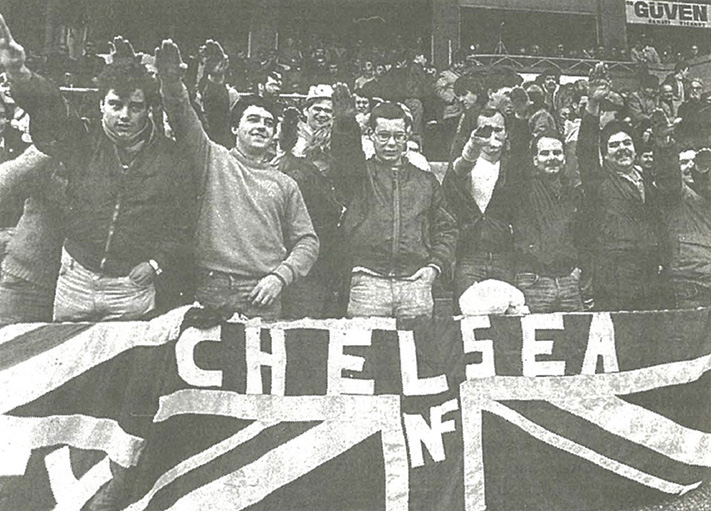
Nazi crew The National Front on the terraces in 1987 Pic credit: Searchlight
It has long been known that the state uses undercover agents to infiltrate political organisations and feed back to the security services all manner of information. The quality of this intelligence, however, is another matter. Recent revelations about police infiltration of an anti-fascist group of football supporters is a case in point.
In 2014, the then Home Secretary Theresa May announced a public inquiry into undercover policing to investigate such outrages. This was prompted by the revelation that undercover officers had gathered intelligence on the family of Stephen Lawrence, infiltrating their campaign for a properly conducted police investigation into the murder of Stephen in 1993 by racist thugs.
Others who have been on the receiving end of appalling behaviour from the Metropolitan Police Special Demonstration Squad, for instance, have now bravely come forward. This includes Helen Steel, of McLibel fame, and other women who were deceived into having relationships with men who, it later transpired, were undercover police officers. In some cases, the relationships led to children. These officers had been given the identities of dead children to provide cover for their work.
Left was main target
The inquiry, led by retired judge Sir John Mitting, is far from completing its work, but the initial findings include much of interest to anti-fascists. Mitting published an interim report in June, presenting his findings into operations between 1968 and 1982, with later years still to be investigated. It is estimated that between 1968 and 2010 some 1,000 groups were spied on. Unsurprisingly, the main targets were anti-fascists and left-wing organisations, with extreme right-far groups considered to be of lesser interest.
Undercover cops such as ‘Doug Edwards’ ‘Paul Gray’ and ‘Colin Clark’ had been set to ‘work’ spying on anti-fascists as part of their infiltration of the Socialist Workers Party. In particular, some officers focused on West Ham football supporters campaigning against fascist activity at the club’s ground.
In the early 1980s, the British Movement (BM) was targeting working-class teenagers at football grounds and music gigs, both in terms of recruitment and to attack the left. There was a BM group on the West side of Upton Park, based around the vicious Morgan brothers. (One of the Morgans later resurfaced in the Football Lads Alliance and mobilised racist Hammers fans.) Several were BM Leader Guard thugs.
Johnny Clark, an active East London anti-fascist, told Searchlight: ‘Twenty‑five to 30 West Ham fans and supporters of the Anti-Nazi League (ANL) regularly leafleted fans at the gates of the ground in 1981, when the ANL was relaunched. This was to counter an emerging BM threat.’
Things came to a head a few years later when West Ham hooligans from the Inter City Firm seriously took on the BM thugs in the Boleyn Tavern. After that, BM was never a significant presence at the ground. The National Front (NF) also turned up regularly at West Ham selling Bulldog, a Young NF hate sheet, round the back of stadium until, under pressure, the club banned them.
Leeds, Chelsea, Leicester and Tottenham ANL supporters were among those who also leafleted the terraces at this time.
The spycops made no difference to Hammers ANL or the ANL nationally. As Johnny Clark said: ‘The mass nature of what we did meant that any attempted infiltration wouldn’t have gained much. Some of those around us, like dockers’ leader Micky Fenn, would have acted quickly and very sharply over such a thing.’
On the periphery
The common view among those active at the time is that the sheer scale of the movement and openness of ANL activity meant that spycops could operate on the fringes, but have little impact. But they did try: one West Ham ANL member thinks that ‘Colin Clark’ and ‘Paul Gray’ may have tried to incite ANL members to covertly attack known NF members. However, they stupidly put the plan to Fenn, who gave them short shrift.
Johnny Clark observed: ‘If you weren’t a face, like Micky, then obviously you’re going to arouse suspicions if you suggested anything adventurous.’ This caution helped confine the activity of spycops to the periphery of the movement.
‘Colin Clark’ has claimed he fears retribution if he is identified, so it has been agreed that he will not be called to give evidence to the inquiry. He has, however, stated that it was right to spy on the ANL because it was known ‘to use violence and seek confrontation’.
However, there was little attention paid to the far right, despite its considerable propensity for violence. Anti-fascists were seen as the greater threat to the state and that spying on the NF, the inquiry has been told, would have been ‘too dangerous’. Tell that to the many brave souls who infiltrated the extreme right for Searchlight and the anti-fascist movement.
The inquiry will, hopefully, hold characters such as Clark and Gray up to further public scrutiny. There are still issues at West Ham, but as Johnny Clark said: ‘We held our ground, and a lot of fans came to respect our stance. The BM never really tried it on with us and the spooks, whatever they intended, were clearly non-League standard, in all ways.’
This article was first published in the Autumn 2023 issue of Searchlight.
